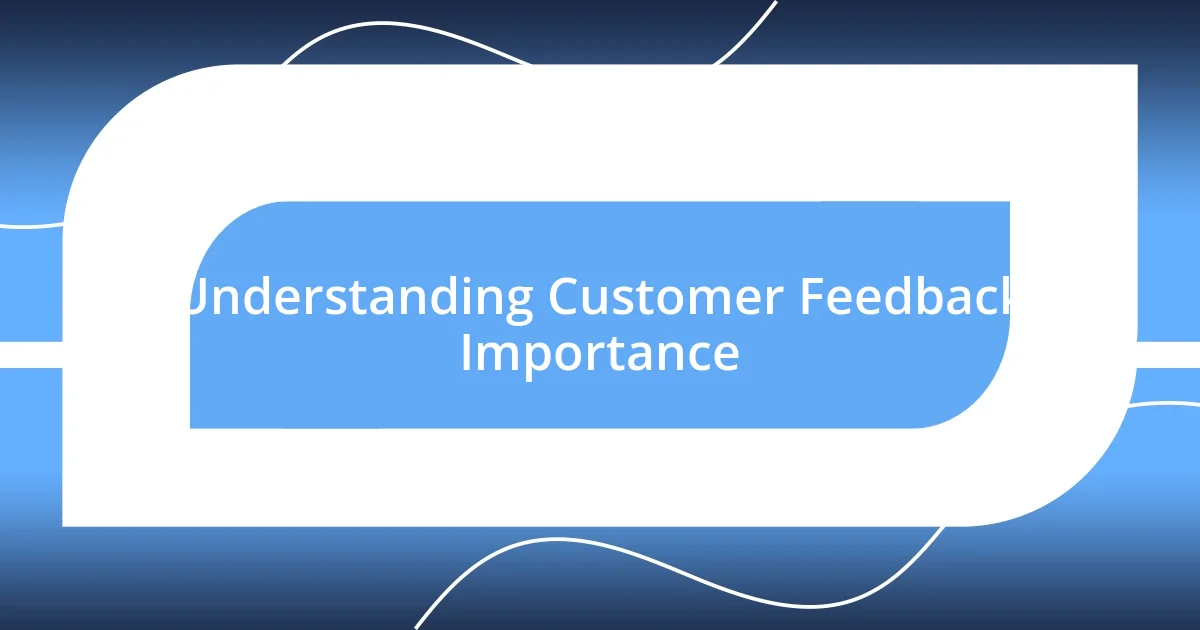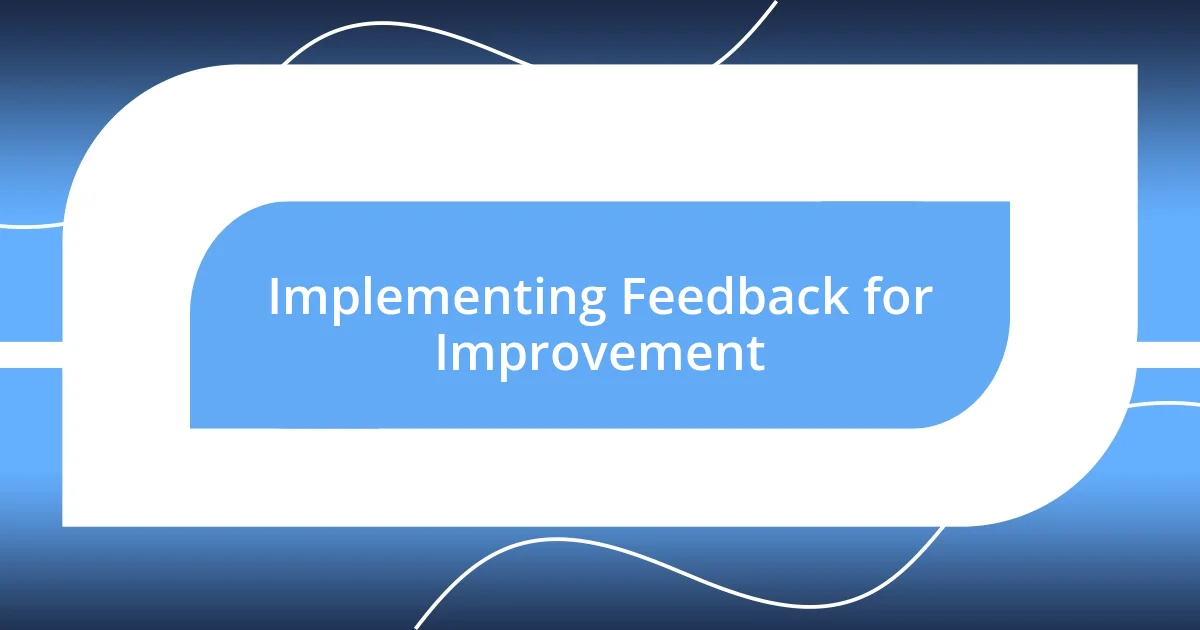Key takeaways:
- Customer feedback is crucial for building trust, loyalty, and innovation, transforming one-time buyers into long-term advocates.
- Establishing clear feedback goals and choosing effective channels enhances the relevance and quality of insights gathered from customers.
- Implementing feedback systematically, closing the loop with customers, and measuring impact on KPIs are essential for continuous improvement and success.

Understanding Customer Feedback Importance
Customer feedback is like a compass for any business. I remember once receiving a single comment from a customer that prompted us to rethink our product design entirely. That small piece of feedback led to a major overhaul that not only enhanced user satisfaction but also improved our sales significantly. Isn’t it amazing how one voice can steer a whole company?
Understanding the importance of customer feedback goes beyond just making necessary adjustments; it builds trust and loyalty. I’ve witnessed how customers appreciate being heard when they see their suggestions put into action. Have you ever felt valued when your opinion was acknowledged? That connection can turn a one-time buyer into a lifelong advocate for your brand.
Moreover, customer feedback serves as a powerful tool for innovation. I once encouraged my team to analyze customer reviews, and the insights uncovered led us to develop a new feature that our users didn’t even know they wanted! It’s fascinating how listening can spark creativity. When you embrace feedback, you open the door to endless possibilities for growth and improvement.

Defining Clear Feedback Goals
Defining clear goals for customer feedback is essential to ensure that you’re gathering the right insights. From my experience, it’s incredibly easy to get lost in the sea of feedback without a clear purpose. I recall a project where we lacked a focused objective, leading to a jumble of data that didn’t drive action. Once we defined our goals, such as identifying satisfaction levels or discovering pain points, the feedback became far more actionable and aligned with our vision.
To set effective feedback goals, consider these steps:
- Identify Key Areas: Determine what aspects of your product or service need insight.
- Involve Your Team: Collaborate with different departments to understand what feedback is crucial for their functions.
- Specify Outcomes: Clearly define what you hope to achieve with the feedback, like improving customer retention or product features.
- Prioritize Actions: Decide which feedback is most important and actionable based on your business objectives.
- Review and Adjust: Regularly evaluate your goals and adapt them as trends and customer needs evolve.
When I finally understood the importance of these steps, it transformed how we approached feedback. Each collected opinion began to feel like a stepping stone toward a more tailored and successful customer experience.

Choosing Effective Feedback Channels
Choosing the right channels for gathering customer feedback can significantly impact the quality of insights you receive. From my perspective, it’s essential to align the feedback method with your customer base. I recall experimenting with multiple channels, including email surveys and social media polls. Surprisingly, I found that my audience preferred quick social media interactions over lengthy email surveys. It’s like discovering a favorite flavor; sometimes it takes a few tries to find what resonates best.
Another consideration is the level of detail you want from the feedback. My team once opted for in-depth interviews, thinking we’d get rich insights—only to discover that many customers found the format intimidating. Shorter, more casual methods like quick surveys can yield just as much valuable information without overwhelming respondents. This approach also fosters a friendly dialogue, which I think customers appreciate.
Ultimately, effective feedback channels depend on understanding both your customers and your objectives. I’ve seen firsthand the difference engaging with customers directly through platforms they frequent makes in fostering an open line of communication. When customers feel comfortable sharing their thoughts, the richness of their feedback can truly enhance the customer’s journey and shape the future of your offerings.
| Feedback Channel | Pros |
|---|---|
| Social Media | Quick and engaging; high visibility |
| Email Surveys | In-depth insights; targeted lists |
| Live Chat | Real-time interaction; quick resolution |
| In-Person Interviews | Deep personal connection; rich contextual feedback |
| Focus Groups | Diverse perspectives; collaborative insights |

Designing Targeted Feedback Questions
Designing targeted feedback questions is the key to unlocking meaningful insights from your customers. I remember once crafting a survey with overly broad questions; it felt like trying to catch lightning in a bottle. Instead, I learned to be specific. Asking questions like, “What features do you find most useful?” leads to precise answers that are actionable. It’s a bit like honing in on a target instead of throwing darts blindly.
In my experience, using a mix of open-ended and closed questions creates a balanced feedback loop. For instance, following up a rating question like, “How likely are you to recommend us?” with, “What influenced your rating?” opens the door for deeper understanding. This combination not only gauges satisfaction but also dives into the ‘why’ behind the numbers. Have you ever been surprised by what customers reveal when given the chance to elaborate? I know I have, and those moments often change my perspective entirely.
It’s crucial to give thought to the language we use in our questions. I once crafted a query that seemed straightforward but used jargon that left customers puzzled. I quickly learned to keep my language simple and relatable. When users feel the questions resonate with their experiences, they’re more inclined to share genuine feedback. Wouldn’t you agree that clarity breeds honesty in responses? Designing questions thoughtfully can transform feedback into a valuable tool for growth and enhancement of customer experience.

Analyzing Feedback for Insights
Analyzing feedback can feel daunting at first, but I’ve found it to be an enlightening process. I remember the first time my team and I sifted through a mountain of comments from a recent product launch. At first, it seemed overwhelming, but as we categorized the feedback—positive, negative, and suggestions—we began to spot trends. Isn’t it fascinating how patterns can emerge when you take the time to dig deeper?
One of the most striking insights I’ve gained is the importance of reading between the lines. There was a time when I received feedback that seemed purely critical, but after a closer look, I noticed a recurrent theme: customers wanted more detailed explanations of features. This revelation led to the creation of tutorial videos that significantly boosted user satisfaction. Have you ever experienced a moment where customer feedback transformed your entire approach? That’s the power of truly listening.
Also, don’t underestimate the value of combining qualitative and quantitative data. I vividly remember presenting a report that juxtaposed numerical ratings with personal anecdotes from customers. The numbers told one story, but the individual experiences added depth and context, painting a fuller picture. This blend of data not only enriched our analysis but also helped us connect with our customers on a more emotional level. Isn’t it thrilling to see how feedback can drive meaningful change?

Implementing Feedback for Improvement
Implementing feedback effectively is where the real magic happens. I recall a time when we received suggestions for enhancing our customer support responsiveness. Rather than just acknowledging the input, we took a proactive approach. We established a dedicated team focused on addressing these concerns, which ultimately led to a noticeable improvement in customer satisfaction scores. Have you noticed how a simple change in process can make all the difference?
What’s fascinating is the impact of closing the feedback loop. When we acted on specific suggestions, like improving our FAQ section based on direct customer input, I made it a point to follow up with those who originally provided the feedback. Their gratitude was palpable, and it reinforced their loyalty to our brand. It’s amazing how involving customers in the improvement process can nurture a deeper connection. Isn’t that a powerful way to show that their voices are valued?
Moreover, it’s essential to track the effectiveness of changes over time. After we implemented a new feedback-driven feature, I set up regular check-ins to evaluate its performance and gather ongoing insights. This iterative approach not only strengthened our relationship with customers but also demonstrated our commitment to continuous improvement. Have you considered how tracking can turn feedback implementation into an evolving conversation instead of a one-off effort?

Measuring Feedback Impact on Success
The impact of customer feedback on success is often measured by analyzing changes in key performance indicators. I remember a time when we introduced a new feature based directly on user suggestions. After its launch, I was thrilled to see our engagement metrics skyrocket. It made me wonder: how many other insights are waiting to be uncovered from simply listening to our customers?
Seasonal reviews can also provide a clearer picture of feedback’s impact. I made it a habit to compare metrics before and after implementing feedback-driven improvements. For instance, our customer retention rate improved dramatically in the months following enhancements made to our onboarding process. It’s like having a scoreboard that reflects the true value of listening—doesn’t that motivate you to keep refining your approach?
Additionally, customer testimonials serve as a powerful qualitative measure of feedback impact. One time, a customer shared a heartfelt note about how a particular adjustment we made had improved their experience. These testimonials not only resonate with my team but also remind us why we value customer input in the first place. Have you ever found inspiration in the stories your customers tell? It’s those moments that reaffirm the connection between feedback and success.












